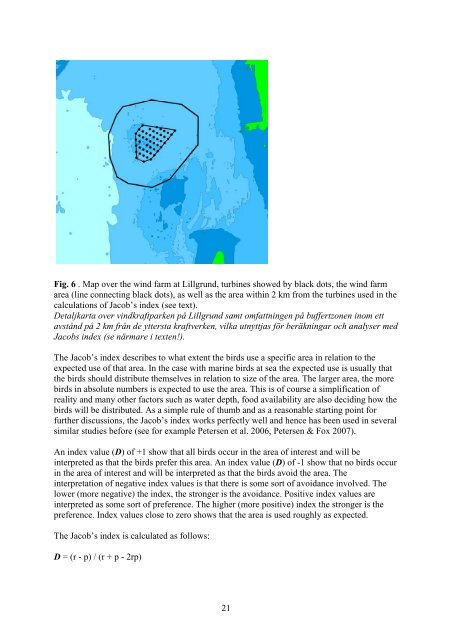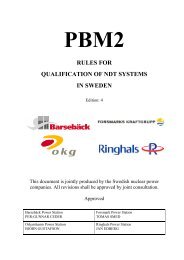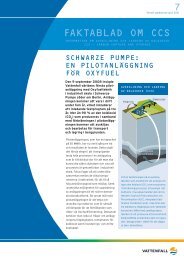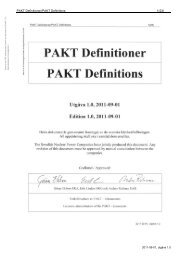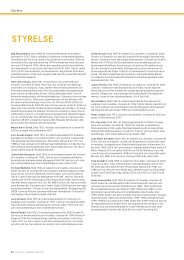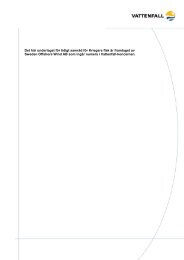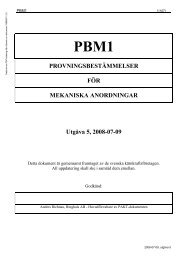Birds in southern Öresund in relation to the wind farm at ... - Vattenfall
Birds in southern Öresund in relation to the wind farm at ... - Vattenfall
Birds in southern Öresund in relation to the wind farm at ... - Vattenfall
Create successful ePaper yourself
Turn your PDF publications into a flip-book with our unique Google optimized e-Paper software.
Fig. 6 . Map over <strong>the</strong> w<strong>in</strong>d <strong>farm</strong> <strong>at</strong> Lillgrund, turb<strong>in</strong>es showed by black dots, <strong>the</strong> w<strong>in</strong>d <strong>farm</strong><br />
area (l<strong>in</strong>e connect<strong>in</strong>g black dots), as well as <strong>the</strong> area with<strong>in</strong> 2 km from <strong>the</strong> turb<strong>in</strong>es used <strong>in</strong> <strong>the</strong><br />
calcul<strong>at</strong>ions of Jacob’s <strong>in</strong>dex (see text).<br />
Detaljkarta over v<strong>in</strong>dkraftparken på Lillgrund samt omf<strong>at</strong>tn<strong>in</strong>gen på buffertzonen <strong>in</strong>om ett<br />
avstånd på 2 km från de yttersta kraftverken, vilka utnyttjas för beräkn<strong>in</strong>gar och analyser med<br />
Jacobs <strong>in</strong>dex (se närmare i texten!).<br />
The Jacob’s <strong>in</strong>dex describes <strong>to</strong> wh<strong>at</strong> extent <strong>the</strong> birds use a specific area <strong>in</strong> <strong>rel<strong>at</strong>ion</strong> <strong>to</strong> <strong>the</strong><br />
expected use of th<strong>at</strong> area. In <strong>the</strong> case with mar<strong>in</strong>e birds <strong>at</strong> sea <strong>the</strong> expected use is usually th<strong>at</strong><br />
<strong>the</strong> birds should distribute <strong>the</strong>mselves <strong>in</strong> <strong>rel<strong>at</strong>ion</strong> <strong>to</strong> size of <strong>the</strong> area. The larger area, <strong>the</strong> more<br />
birds <strong>in</strong> absolute numbers is expected <strong>to</strong> use <strong>the</strong> area. This is of course a simplific<strong>at</strong>ion of<br />
reality and many o<strong>the</strong>r fac<strong>to</strong>rs such as w<strong>at</strong>er depth, food availability are also decid<strong>in</strong>g how <strong>the</strong><br />
birds will be distributed. As a simple rule of thumb and as a reasonable start<strong>in</strong>g po<strong>in</strong>t for<br />
fur<strong>the</strong>r discussions, <strong>the</strong> Jacob’s <strong>in</strong>dex works perfectly well and hence has been used <strong>in</strong> several<br />
similar studies before (see for example Petersen et al. 2006, Petersen & Fox 2007).<br />
An <strong>in</strong>dex value (D) of +1 show th<strong>at</strong> all birds occur <strong>in</strong> <strong>the</strong> area of <strong>in</strong>terest and will be<br />
<strong>in</strong>terpreted as th<strong>at</strong> <strong>the</strong> birds prefer this area. An <strong>in</strong>dex value (D) of -1 show th<strong>at</strong> no birds occur<br />
<strong>in</strong> <strong>the</strong> area of <strong>in</strong>terest and will be <strong>in</strong>terpreted as th<strong>at</strong> <strong>the</strong> birds avoid <strong>the</strong> area. The<br />
<strong>in</strong>terpret<strong>at</strong>ion of neg<strong>at</strong>ive <strong>in</strong>dex values is th<strong>at</strong> <strong>the</strong>re is some sort of avoidance <strong>in</strong>volved. The<br />
lower (more neg<strong>at</strong>ive) <strong>the</strong> <strong>in</strong>dex, <strong>the</strong> stronger is <strong>the</strong> avoidance. Positive <strong>in</strong>dex values are<br />
<strong>in</strong>terpreted as some sort of preference. The higher (more positive) <strong>in</strong>dex <strong>the</strong> stronger is <strong>the</strong><br />
preference. Index values close <strong>to</strong> zero shows th<strong>at</strong> <strong>the</strong> area is used roughly as expected.<br />
The Jacob’s <strong>in</strong>dex is calcul<strong>at</strong>ed as follows:<br />
D = (r - p) / (r + p - 2rp)<br />
21


